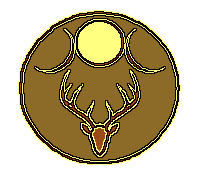



In the Craft, we make a lot of use of the circle as a symbol, in no little part
because so much of our particular vision of the way the Universe works involves cycles
that repeatedly return to their points of origin. We envision the progress of the year in
this way, as an endless turning of one season into another into another, always moving yet
unchanging, in that everything always happens in the same order, Spring after Winter,
Summer after Spring, and so on. Some poetic soul somewhere, somewhen, likened the turning
of the seasons to the turning of a wheel, and the metaphor of the Wheel of the Year has
now passed into common usage within the Craft. The fact that we modern Wiccans celebrate
eight seasonal festivals at roughly equal intervals throughout the year only makes the
image of the year as a Wheel all the more attractive, as it lends itself to being drawn
out as an eight-spoked wheel. (Yes, I *do* know that the Buddhists use an eight-spoked
wheel as one of their religious symbols. I not aware of any connection between the two
ideas, and feel absolutely no inclination whatsoever to speculate on the matter. This is
either entirely coincidental, or the result of a connection and cross-fertilization with
which I am not yet prepared to deal.)
One of the important things to remember about the Wheel is that it *never* stops turning.
The Wheel itself has no beginning of which any of us is aware, and it has no end which we
can foresee. We may speak of a year as having a beginning and an end, because we are human
and have this odd compulsion to measure time, but the Wheel keeps turning, regardless of
what we may do. It helps, sometimes, on those cold grey days in January, to remind oneself
that the Wheel *is* turning, and Spring *will* indeed come 'round again.
The eight Wiccan major holidays, (which are referred to in some traditions as Sabbats,)
can be divided into two groups of four: the Quarter Days, which are observed on or near
the solstices and the equinoxes; and the Cross-Quarter Days, which are observed roughly
halfway between the Quarter Days, on or about the ends of January, April, July, and
October. Some times you will see these holidays shown as taking place on the first day of
the months following the ones mentioned immediately above: i.e., Beltane on the 1st day of
May, and it is not unknown for people to have serious arguments about whether Lammas
should more properly be celebrated on July 31 or August 1. Which is a bit silly, since of
old these festivals were occasioned *not* by the passage of days marked on a calendar, but
by events that took place in the everyday lives of the celebrants.
Something that helps sometimes, in working with the concept of the Wheel and its eight
festivals, is to imagine that one is part of a primitive society, without all our modern
scientific knowldge and records and calendars and almanacs. When all one has with which to
measure the passage of time is the passage of the days and the turning of the seasons, one
begins to place great significance in events previously considered to be of minor
importance. Look at each of the feasts in the Wheel, and think about what is happening in
the world around the celebrants as the time for the feast draws near, and you will draw
new insights into the meaning of, and the reason for the feast.

 Samhain - Oct 31
Samhain - Oct 31
 Yule - Dec 21-23
Yule - Dec 21-23
 Imbolc - Feb 1
Imbolc - Feb 1
 Oestara - Mar 21-23
Oestara - Mar 21-23
 Beltane - May 1
Beltane - May 1
 Litha - June
21-23
Litha - June
21-23
 Lammas or Lughnassad - Aug 1
Lammas or Lughnassad - Aug 1
 Mabon - Sep 21-23
Mabon - Sep 21-23


Last updated January 23, 1999
![]()


![]()
![]()
![]()